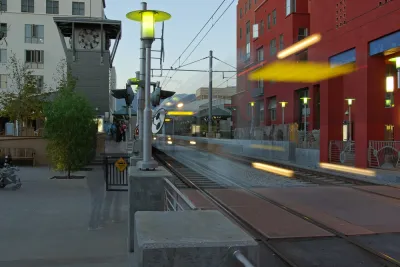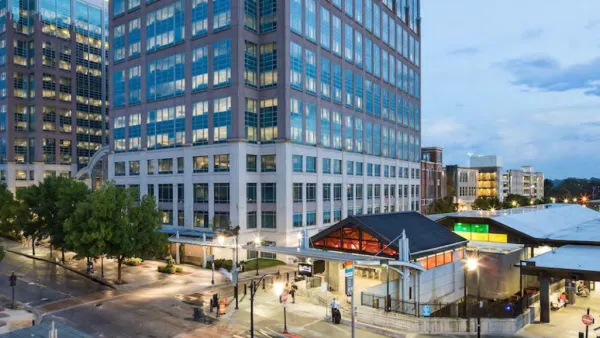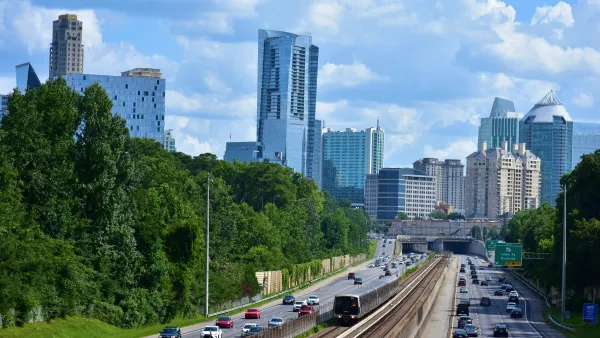Driven by a need to meet growing costs amid unstable federal subsidies, metropolitan transit agencies are eying their properties, particularly parking lots, as money makers from new residential and commercial development.

"Transit officials expect real estate to become an increasingly important revenue source, amid stagnant federal funding and rising costs of upkeep for aging systems," writes Chelsey Dulaney of The Wall Street Journal.
She describes the real estate endeavors of four major transportation agencies in the U.S. that are actively engaged in leasing properties around rail stations. While other reasons besides revenue may be a motivation, such as improving rail ridership, only revenue considerations are discussed.
- "Art Leahy, chief executive of the Los Angeles County Metropolitan Transportation Authority (Metro), said the authority has been involved in so many development that it is now one of the largest public real-estate developers in Los Angeles County, with thousands of residential units—many designated as affordable—on properties the agency owns and leases to developers. In addition to annual rent payments, Metro also has profit-sharing agreements with some developers.
- "The Washington Metropolitan Area Transit Authority’s 18-person real-estate team, one of the oldest and most established among transit agencies, both sells and leases excess land around its 91 rail stations.
- For developers, this is the best real estate,” said Stan Wall, who heads the agency’s real-estate office. “It’s the best place to be in the region.
- "Now, facing a $15 billion funding gap for its capital program, (New York’s Metropolitan Transportation Authority) has made plans to lease out or sell about (11) lots, including the agency’s headquarters in Manhattan." However, Dulaney indicates that most of the properties are "parking lots used by suburban train commuters.
- “We’ve made a huge effort to comb through our real-estate portfolio and identify parcels that could potentially be used for revenue,” said MTA spokesman Aaron Donovan
- "The Metropolitan Atlanta Rapid Transit Authority, called Marta, is negotiating leases for three parcels with developers that are planning to build more than 1,400 residential units on parking lots owned by Marta and about 50,000 square feet of retail space around Marta stations."
It may strike readers as unusual that the term, transit oriented development (TOD) is not mentioned for these developments located at rail stations. The primary motivation is not smart growth, increasing density, or decreasing vehicle miles traveled. It's income to meet growing transit needs and budgets.
Federal funding is “growing at really a very modest pace, and the bottom line is we’re not keeping up with demand to expand service or demand to replace vehicles,” said Rob Healy, a vice president at the American Public Transportation Association, an advocacy group.
FULL STORY: Transit agencies mine property developments for revenue

National Parks Layoffs Will Cause Communities to Lose Billions
Thousands of essential park workers were laid off this week, just before the busy spring break season.

Retro-silient?: America’s First “Eco-burb,” The Woodlands Turns 50
A master-planned community north of Houston offers lessons on green infrastructure and resilient design, but falls short of its founder’s lofty affordability and walkability goals.

Delivering for America Plan Will Downgrade Mail Service in at Least 49.5 Percent of Zip Codes
Republican and Democrat lawmakers criticize the plan for its disproportionate negative impact on rural communities.

Test News Post 1
This is a summary

Test News Headline 46
Test for the image on the front page.

Balancing Bombs and Butterflies: How the National Guard Protects a Rare Species
The National Guard at Fort Indiantown Gap uses GIS technology and land management strategies to balance military training with conservation efforts, ensuring the survival of the rare eastern regal fritillary butterfly.
Urban Design for Planners 1: Software Tools
This six-course series explores essential urban design concepts using open source software and equips planners with the tools they need to participate fully in the urban design process.
Planning for Universal Design
Learn the tools for implementing Universal Design in planning regulations.
EMC Planning Group, Inc.
Planetizen
Planetizen
Mpact (formerly Rail~Volution)
Great Falls Development Authority, Inc.
HUDs Office of Policy Development and Research
NYU Wagner Graduate School of Public Service





























